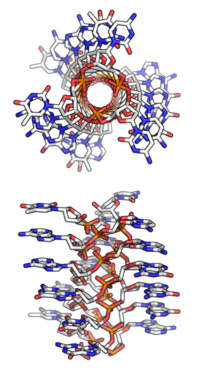
Photo from wikipedia
G-quadruplexes (G4) are now extensively recognised as a peculiar non-canonical DNA geometry that plays a prime importance role in processes of biological relevance whose number is increasing continuously. The same… Click to show full abstract
G-quadruplexes (G4) are now extensively recognised as a peculiar non-canonical DNA geometry that plays a prime importance role in processes of biological relevance whose number is increasing continuously. The same is true for the less-studied RNA G4 counterpart. G4s are stable structures; however, their geometrical parameters may be finely tuned not only by the presence of particular sequences of nucleotides but also by the salt content of the medium or by a small molecule that may act as a peculiar topology inducer. As far as the interest in G4s increases and our knowledge of these species deepens, researchers do not only verify the G4s binding by small molecules and the subsequent G4 stabilisation. The most innovative studies now aim to elucidate the mechanistic details of the interaction and the ability of a target species (drug) to bind only to a peculiar G4 geometry. In this focused review, we survey the advances in the studies of the binding of small molecules of medical interest to G4s, with particular attention to the ability of these species to bind differently (intercalation, lateral binding or sitting atop) to different G4 topologies (parallel, anti-parallel or hybrid structures). Some species, given the very high affinity with some peculiar G4 topology, can first bind to a less favourable geometry and then induce its conversion. This aspect is also considered.
Journal Title: Molecules
Year Published: 2022
Link to full text (if available)
Share on Social Media: Sign Up to like & get
recommendations!